The
sable Shepherd
"A museum piece"?
By Margit and Thijs van Dorssen(von
Arlett)
Many thanks to the van
Dorssens for allowing me to
place this excellent article on my website

Especially in the
southern European countries the sable shepherd is not
particularly popular, especially among breeders of the
so called Show Lines. I cannot tell you why this is so.
Still, I would like to try to get rid of some of the prejudices.
My aim is not to turn
every reader of these lines into a passionate fan of sable
dogs in half an hour. I want to try to explain, in an
understandable way,
why and how to use the hereditary qualities of the sable
dog in your breeding program
in a sensible and clever way.

Before getting to
the actual point, here is a little theory first.
Under the chapter
characteristics of the German Shepherd dog we find the
following descriptions of the permitted colors:
Black with red-brown,
brown, yellow to bright gray marks. Black uni-color, gray,
darkly clouded over, black saddle and mask. Inconspicuous,
small, white chest marks, as well as bright colored insides
are allowed but not desired. The nose has to be black
for dogs of all color variations. Missing mask, bright
or even piercing color of the eyes as well as light or
whitish marks on the inner sides, bright claws and a red
tip of the tail are to be assessed as pigmentation weakness.
The under-wool shows a light gray color. The color white
is not permitted.
I don’t want
to get deeper into the genetic basics of these colors.
This can be studied in publications like for example "Schleger".
In this article I
will refer to the black and yellows, black and reds or
black and browns as black and brown to keep things simple.
The sable color is
described differently from different points of view.

All of the following
variations are to be considered as "sable", whereby more
or less bright cheeks and bright inner marks all count
to this "sable".
Sable color
-
Gray (Wolf)
-
Gray-black
-
Black-gray
-
Gray-brown
-
Gray-yellow
-
Gray, darkly cluoded over
-
Gray clouded, mask
-
Dark gray, mask
-
Gray, brown-black clouds
-
Gray-brown with black marks on the legs and toes
-
Gray, brown marks on the head and legs, mask
-
Dark gray, dark line on the middle of the back (Aalstrich)
-
Middle gray
-
Bright gray
-
Pale gray

Up to middle gray
all variations are desirable and not to be penalized,
except for bright cheeks and pronounced paleness on parts
of the legs.
Trying to diversify
these color variations will probably lead to many different
opinions-as far as the descriptions is concerned. The
official, listed variations of the sable color can be
found on the German pedigree.
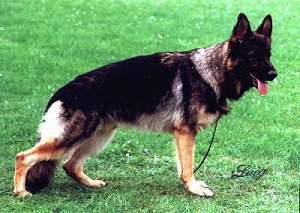
The original color
categorization made when the dog is tattooed often seems
to be incorrect when you see this dog three years later.

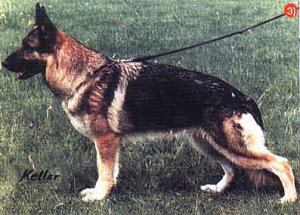
An
Example:
The gray-bright yellow
dog with a dark line on the middle of the back has turned
into a deep dark-gray-brown dog. And vice versa, the dark-gray-brown
dog has turned into a gray-yellow dog.
This development,
which at first sight is not evident, (seems hard to believe)
is not so rare after all.
It is certain, that
as a rule of thumb, a sable develops his final color up
till the age of three.


Based upon my experiences
as a breeder, I believe that one can say that the extend
to which the mask or the pigmentation of the outer ear
is pronounced or not, can be indicative for the extend
of pigmentation the sable dog will have as an adult.
In this correlation,
one can ask the question:
When is
a dog sable?
As a matter of
principal,
the sable color of a dog is determined
directly
after birth. At that very moment,
it is defined if a dog is black, black & brown, or
sable.


This is what the pups
will look like later.

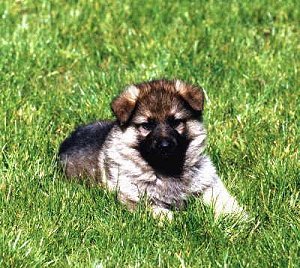

I am often asked where
the sable color comes from on an adult black & yellow
dog with no solid black saddle.
This
is not a sable dog, he just doesn’t have a solid
black saddle.
It is a fact however,
a gray & yellow dog as a puppy is sometimes hard to
distinguish from a black & yellow one that doesn’t
have a solid, closed black saddle.
In no way, can we
now start correcting the original color of this dog on
the pedigree and turn him into a sable dog because he
will never be a sable.
Therefore, he will
not be able to improve pigmentation either.
This brings up the
following question:
Does a
sable dog really improve the pigmentation?
One really should
not believe that sable dogs can do miracles to the pigmentation,
especially in a population where for decades, the black
& brown to red or the bright yellow dog was preferred.

This can not be done
in one single step or only to a very limited extend.
In certain cases some
fast changes can be brought about by a sable dog. More
about that later.
Both
color variations, black & brown as well as sable,
have one thing in common:
When they
are multiplied among each other without consideration
or target, more or less pronounced color reductions will
appear in both cases.
The brightening will
be more pronounced in the case when the natural effect
of the Mendel Laws will make a heavily frequented dog
appear as a brightener, although he doesn’t necessarily
have to be a clear or bright colored dog himself.
If after the 3rd
or 4th generation of sole black & brown
breeding, a sensible gray combination is made, or the
other way around, if after several generations of purely
sable cross-breedings
a black & brown combination
is made, no
loss of pigmentation
will occur.

People often say that
a well pigmented black & brown animal, who in his
turn, has one sable parent, produces a better pigmentation
for both the sable as well as for the black & brown
offspring.
Or that: sable
combined with sable always gives a brighter, clearer sable.
As far as my own personal
experience goes, this is basically correct.
But the line of succession, cannot
be assessed in such a general, overall way. It is not
true either that in a population, where 95% is black &
yellow, the sable factor will become insignificant in
the genetic material. The
contrary is true.
Because of the consecutive
black & yellow sequence of the breedings, a so called
consolidation will occur, i.e. a compression or a condensation
of the black & yellow alleles, a certain condition
of the gene, which is comparable to a intensive inbreeding
involving several generations and thus will have a negative
influence on the vitality of the alleles. (here: pigmentation
will decrease)
The
sable gene cannot loose intensity or brighten in this
case because it is not being challenged in these black
& yellow combinations.
Therefore the transmission
of the pigmentation underlies certain rules, in a similar
way as the transmission of long coat. If a homozygous
partner in black & brown (if such a dog exists at
all) is combined with a homozygous sable partner, the
color of the offspring would be in-between the color of
the parents. Theoretically, we would find pups with the
following colors: Gray-brown, gray-black, gray-brown or
gray-black clouded over.
As I indicated before,
I do not know of any dog that evidently has dominantly
passed on his black & brown color to more than 100
of his offspring, of course in a combination with a sable
partner.
Also the dominantly
producing sable dog (I personally don’t know any)
would pass on his color or his color variation "sable"
to all of his offspring, including the pups stemming from
a black & brown – sable combination.
The dog
that dominantly produces sable does
have one huge advantage, he
is homozygous for shorthair,
this means, he does
not produce long coats at all. If a dominantly producing
sable dog would be known nowadays, he would certainly
present a way to at least restrict the problem with long
coats on a short term.
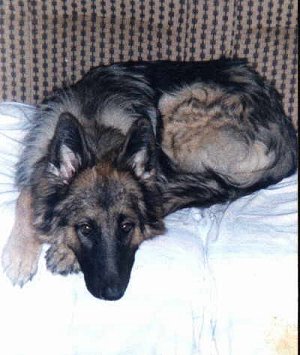
Nobody has to fear
now being restricted to the sable color for the rest of
his life once he has used a sable animal.
The hereditary
transmission of the sable color is dominant, not recessive:
This means, and this
is absolutely certain:
Only
when at least one of the parents is sable itself, a sable
pup can be born.
Only
black & brown pups can be born when both parents are
black & brown: No matter how many of their ancestors
were sable.
If in a litter
like this, a sable pup is born, we can be assured that
a sable parent was directly involved.
THIS IS
100% CERTAIN!
On the other hand,
black & brown pups, or even black pups can be born
in a sable – sable combination. This too, isn’t
so rare at all because the black & brown color as
well as the black color is recessive.
Example:
No one who is planning
to use a sable male or female for breeding will be condemned
to the sable color for the rest of his breeders life.
I deliberately say this in such a provoking way, since
very often this is the main argument against the use of
sable dogs in breeding.

If a black & brown
female is bred to a sable male or vice versa, the litter
will statistically consist of an average 50 % of sable
and 50 % of black & brown pups.
If this same breeder
will continue to breed the black & brown dogs from
this litter, -maybe because he simply doesn’t like
the sable color- and combine them with other black &
brown dogs, the offspring will never be sable
again.
The advantage
of the single use of a sable dog is the quick improvement
of the pigmentation in comparison to the parental generation.

Unfortunately, I have
often observed people taking the wrong path.
The breeder with an
extremely bright colored female is thinking about his
last chance, -maybe
a sable dog can do the trick-
and this sable dog is expected to
cure all of the problems that this breeder has neglected
for many, many preceding generations.

His
females predominantly have.....
-
Bright claws
-
No pronounced mask
-
Red tip of the tail
-
No solid black saddle
-
Bright eyes
-
Bright lips, bright gums
-
Bright cushions underneath the paws, in summer too
-
The upper part of the head is missing black
-
White hair in the ears
-
Bright inner sides
- very often, all
these problems are combined in one single female -
And now this breeder
thinks,
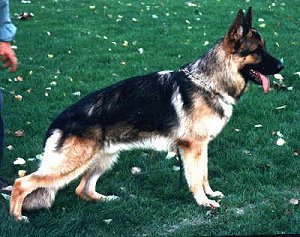
Abracadabra
– a sable male –
and everything
will be all right!!
Sometimes it works,
but only sometimes.
And it is often these
breeders that say:
Sable
is supposed to improve pigmentation?? – Nonsense!!
Nobody
has ever been able to write the secret formula for good
pigmentation. The sensible use of sable dogs certainly
is a way.
If we want to improve
pigmentation we have to pay attention to the practical
hereditary transmission which has to be defined. There
are several different alternatives, if we have statistical
record of how the animal involved produces.
We have the following
alternatives:
To
improve or reinforce the pigmentation of a black &
yellow dog we can follow two paths.
1.
We breed this black & yellow female (with low pigmentation
factor) with a sable dog or with a black & brown male
with a strong pigmentation with ancestors that demonstrably
stem from generations consisting of alternating sable
and black & brown combinations.
These
dogs are most certain to improve pigmentation
For the hereditary
transmission, it is irrelevant whether it is the female
or the male that has the sable or the black & brown
color. The litter with the sable sire, will presumably
consist of sables and well-pigmented black & brown
pups. The litter with the black & brown sire will
consist of black & brown pups only, of course.
A sable
partner, bred purely sable over several generations (either
on the paternal side or on the maternal side) will produce
a less pronounced pigmentation in his sable offspring
as well as in his black & brown offspring.
If we were to breed
a black & yellow female (with low pigmentation) with
a homozygous sable (AA), i.e. a male that dominantly produces
sable, we would get only sable pups in different sable
variations. On average, theoretically, 50% of them would
be homozygous for sable and 50% would be heterozygous
(AB). Since it is our aim to improve the black & yellow
color, we could now theoretically combine this sable offspring
(heterozygous) with a black & yellow partner. This
supposed detour is very troublesome but gives us the advantage
of having a wider choice of sable animals available for
breeding.
Nowadays, this second
way is certainly only a theoretical one, since there is
no existing male (at least that I know of) that dominantly
produces sable.
The attempt to try
to breed a dominantly sable producing dog (homozygous
for sable) would be of highest interest to me. If as a
result, this dog would not be frequented because the prejudices
against the sable color still prevail, this would be a
rather frustrating situation, for me too.
The interested breeder
will probably ask the question where the purely sable
producing dog received his genetic material. In order
to determine that, we don’t have to go back in time
a long way if the parents are sable and split producers
as far as color is concerned. Consequently, only the first
possibility comes into question (Illustration NR. 1),
whereby 25% of the offspring is homozygous for sable.

Here is an example
from my own experience.

My very own male
"Flick von Arlett" –himself not being sable- has
proven with the appearance of his four progeny groups,
to transmit, almost dominantly, his pronounced pigmentation,
especially on the head. This ability to bring about
a clear improvement of pigmentation even with the most
lucid female, can be attributed to his sable ancestry
on the maternal side.
| Yago
v. Wildsteiger Land |
Eiko
v. Kirschental |
Uran
v. Wildsteiger Land |
Irk
v. Arminius |
| Palme
v. Wildsteiger Land |
| Xitta
v. Kirschental |
Lasso
di Val Sole |
| Nimi
v. Kirschental |
| Quina
v. Arminius |
Xaver
v. Arminius |
Lasso
di Val Sole |
| Wilma
v.d. Kisselschlucht |
| Palme
v. Wildsteiger Land |
Nick
v.d. Wienerau |
| Fina
v. Badsee |
| Ursa
von Arlett |
Joker
v. Arlett |
Uran
v. Wildsteiger Land |
Irk
v. Arminius |
| Palme
v. Wildsteiger Land |
| Katze
v.d. Wienerau |
Canto
v. Ammerlandeck |
| Era
v.d. Wienerau |
| Medea
v. Aducht |
Aramis
v. Allamo |
Quai
v.d. Boxhochburg |
| Moni
v. Haus Eyll |
| Wilma
v. Patersweg |
Igor
v. Hylligen-Born |
| Gitta
v. Patersweg |
Due
to the fact that this male is black & brown, he
(just like any other black & brown male) can only
produce sable offspring in combination with a sable
female. As long as he combined with black & brown
females he can only produce black & brown
offspring.
Even when bred in to sable ancestors.

So for the breeders
who absolutely don’t want to use a sable dog,
this is the
way to improve the pigmentation of their breed by using
a sable female. (or in this case one of her black &
brown descendants).

A necessary condition
is of course that this sable female stems from proven
alternating combinations between black & brown and
sable animals.



These are three
males sired by Flick out of three females with totally
different pigmentation.
1. The dam was clear.
2. The dam had a
normal pigmentation.
3. The dam had a
very good pigmentation.
These are three
examples where the dam has not transmitted her pigmentation.
Here you can clearly see how the dam’s pigmentation
is being dominated by the sire.
Here, I would like
to show you a few statistics in correlation with sable
Shepherd Dogs.

This graph shows
us the total number of breeding animals for a period
of twenty years as well as the quota of sable dogs.
The comparison between the former East- and West Germany
is striking.

This graph shows
the share of sable pups in the total number of dogs
registered in the Central Breeding Files (Zuchtbuch)
of the last five years. Even if the percentage of sables
is slightly increasing, the absolute figures are extremely
small. In comparison to 1992 there has been an increase
in 1996 of only 80 sable pups. (We have to keep in mind
that these numbers have been established using only
the distinction of the color gray. The sable varieties
have not been taken into consideration but will be corrected
in foreseeable time)

This graph shows
the number of sable dogs that have been presented at
breed surveys during the time span from 1972 until 1992.
In my opinion, the large increase from 1990 to 1991
is a result of the opening of the former East German
borders. Even at the peak level the number is still
below 20%. As an average, the number of sable dogs at
breed surveys is at approximately 5%.

This of course is
a miscorrelation to the total number of registrations
in the Central Breeding File that could theoretically
lead to the following thesis:
Sable
dogs are more resistant to strain than black & brown
dogs.
Which brings us
to the next topic of incitement :
There have always
been and there will always be discussions about the
value or the non-value of the color in correlation to
the working qualities.
I think
it is basically wrong that sable dogs are more resistant
to strain than black & brown dogs.
I think that the
higher number of sable animals in the working sector
– I would prefer to call it sporting sector- perhaps
has the following reason:
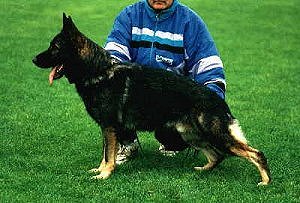
For those in the
working dog area, the color is basically not a selection
criteria. The selection of the dog –if the color
was to play a role at all- was usually based upon the
following philosophy:
If the well-known
dog-owner John Smith and the also well-known Jack Brown
have both been very successful with a sable dog, this
will bring about a spiral movement.
If these dogs really
have the potential to become high performance working
dogs (– this has to be fixed in their pedigree
over several generations –) then these animals
will be increasingly used for breeding. The breeder
as well as the buyer of the pup will of course prefer
the sable pups that have a strong resemblance to their
sire.
A similar movement
was brought about by Bodo and Bernd vom Lierberg. These
dogs were well-known VA's (conformation) that have produced
a number of high performance working dogs.
The fact that the
color doesn’t have an influence on the number of
points that can be won on working dog trials, has certainly
contributed to the lack of prejudices against sables
among breeders of working dogs.
From my experience
I can add a few remarks about qualities that could
possibly be related to the sable
color.
I
want to stress that these are not statements that have
generally been proven to be valid nor have they been
scientifically researched or examined. (as far as my
knowledge goes)
I have been breeding
actively since the year 1978 among others with sable
dogs. My basic selection criteria for my pups absolutely
exclude the color (the choice between sable or black
& brown)
When deciding which
pups from a litter to keep, I prefer pups with the following
qualities in the following order of priority:
Selection criteria
-
High vitality
-
Good playing drive
-
Temperament
-
Good Shepherd Dog expression
-
Strength and substance
-
Harmonious movement
-
Good transmission over the back
-
Color?????? Or rather: pigmentation
Those peculiarities
that I have noticed in over twenty years of breeding
experience and that could
eventually
be related to the sable color,
start at the birth.
At this point, I
would like to encourage the readers to exchange experiences
if they coincide with mine.
Once again, I must
stress that I am referring to my own personal experiences
only made with dogs from my own personal breeding stock.
Peculiarities
seen with sable pups as opposed to black & brown
pups:
The weight at
birth is usually on average a little higher than the
black & brown pups.
Clearly higher
vitality.
Lower mortality
during the first ten days.
Higher weight
when tattooed.
Less heat sensitivity
for pups as well as for the adult dogs on shows as well
as on working dog trials.
Lower susceptibility
for rashes.
I have never
observed bright claws.
More often black
spots on or below the tongue.
I have never
observed bright lips or gums. White hair in the ears
is extremely rare.
Almost all sable
females and many black & browns stemming from sables,
additionally feed their pups out of their own stomach
(throwing up food) in a rather pronounced way.
Now a few other
points where I have not observed any difference between
the colors –again, only from my experience-
-
No difference
in:
-
Duration
of life span
-
Susceptibility
for disease
-
Working
ability
-
Resistance
to strain
To
come to an end, here is a popular way to seemingly improve
the color and Pigmentation in a way that is less time
consuming
Again and again
one can observe that a few, but very "clever" breeders
have their own way of improving pigmentation by using
achievements of the chemical industry in a refined way.
I have to admit
that it is not always easy to recognize these manipulations
at first sight. Apparently there are a few true "experts"
in this sector too.
The personal disappointment
is that these breeders obviously do not recognize their
own "Dead End Street" and apart from that, seem to have
forgotten
(or maybe
suppressed)
the true color of their dogs when
selecting a breeding partner.
These manipulations
sometimes do not just implicate a single animal. When
a highly frequented stud dog is involved, it is a big
irresponsibility and a great long term damage to the
whole race.
Perhaps
these breeders should consider using a breeders natural
means of improving pigmentation.

----------------------------
Wouldn’t
it be a great pity if the sable German Shepherd would
wither away in the second age of it’s existence
to become a "Museum piece"?
The
"sable" Shepherd deserves acceptance!
.......not
only for his qualities as an improver of pigmentation!
Color
diversity means genetic diversity!
genetic
diversity means vitality and fitness!
--------------------------
I
am interested in opinions, questions, comments, experiences
and so on about this topic and maybe some other lovers
of the sable color are interested too.
Please send
your comments by e-mail to vandorssen@arlett.de